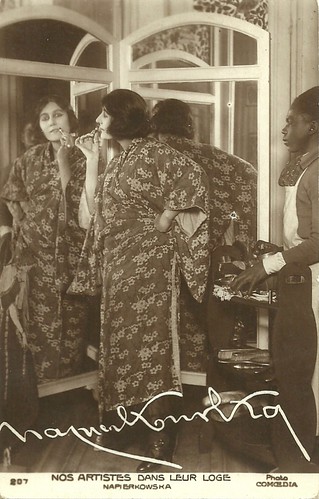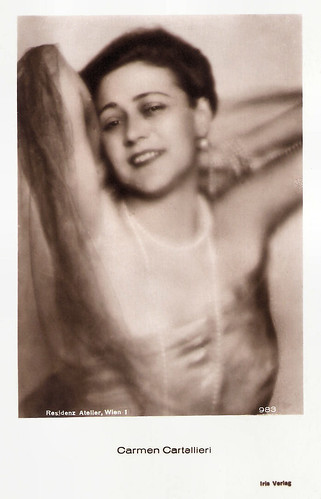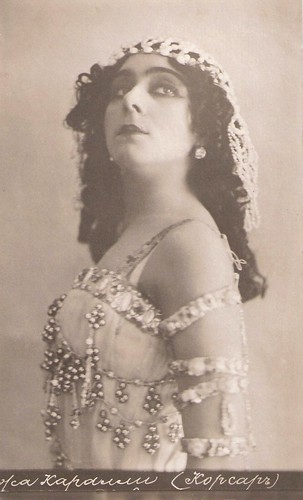Russian-Lithuanian actress Elisabeth Pinajeff (1900-1995) starred in 33 German and French films in the 1920's and 1930's. She was married to famous photographer Alex Binder. In the 1950's she was involved in a notorious scandal involving erotic ballets with underaged girls, the 'Ballets roses' scandal.
![Elisabeth Pinajeff]()
Austrian postcard by Iris-Verlag, no. 5212. Photo: Aafa-Film / Lux-Film-Verleih.
![Elisabeth Pinajeff]()
German postcard by Ross Verlag, no. 951/1, 1925-1926. Photo: Kiesel, Berlin.
About the birth of Elisabeth Pinajeff or Elisabeth Pinajewa, our sources state different dates and locations. While Philippe Pellettier at the French website Ciné-Artistes indicates that she was born 4 April 1900 in Wilna (Vilnius), then part of the Russian Empire and now Lithuania, his German colleague Thomas Staedeli of the Cyranos website writes instead that she was born 17 April 1900 in Jekaterinoslaw, now Dnipropetrowsk in Ukraine. (She probably was born in Vilnius, and grew up in Dnipropetrowsk).
However, Pinajeff was the daughter of architect Serge Pinajeff and countess Anna Popov. In the 1910s she did her studies in Kharkiv (Charkow), in Ukraine, and attended dramatic classes too.
She supposedly played in two silent Russian films, but which ones is unknown. At age 19 she married an engineer. When her husband got a job in Germany, she moved there with him.
Her film career chance came in 1921, when Danish director Carl Theodor Dreyer advertised in a newspaper that he was looking for authentic Russians to play in his first German film Die Gezeichneten/Love One Another (Carl Theodor Dreyer, 1921). Elisabeth Pinajeff got a small part in the film and not the female lead, as Philippe Pellettier writes. The leading lady was countess Polina Piechovska, while the male lead was played by Vladimir Gajdarov.
Subsequently, Pinajeff contributed to many silent German films, often as a classy seductress. She already had the second female lead in one of her next German films, Königsliebchen/Darling of the King (Heinz Schall, 1924), opposite Ruth Weyher and Bruno Kastner.
In the mid-1920s Elisabeth Pinajeff often was the second actress after the female star, and so she was destined to play the rival, as in Die Brigantin von New York (Hans Werckmeister, 1924) with Lotte Neumann, and in Herrn Philip Collins Abenteuer/Mr Philip Collins Adventure (Johannes Guter, 1925) with Georg Alexander and Ossi Oswalda.
In 1926 she had the female lead in the aristocratic drama Spitze'/Have an eye (Holger-Madsen, 1926) opposite Olaf Fönss. She played the dancer Beatrice opposite Luciano Albertini in the adventure film Rinaldo Rinaldini (Max Obal, 1926-1927).
Pinajeff co-starred with Alphons Fryland in Gern habe ich die Frauen gekusst/Gladly I have kissed the women (Bruno Rahn, 1926), and she was one of the three models in Die drei Mannequins/The Three Mannequins (Jaap Speyer, 1926).
Next, she played opposite Maly Delschaft in Die Kleine und ihr Kavalier/The Little One and her Gentleman (Richard Lowenstein, 1926), opposite Livio Pavanelli and Hans Albers in Die lachende Ehemann/The laughing husband (Rudolf Walther-Fein, 1926), with Xenia Desni in Ein rheinisches Mädchen beim rheinischen Wein/An Honest Girl with an Honest Wine (Johannes Guter, 1927), and with Liane Haid in Die Dollarprinzessin und ihre sechs Freier/The Dollar Princess and Her Six Lovers (Felix Basch, 1927).
In the late 1920s, Pinajeff starred in the Austrian productions Wem gehört meine Frau/To Whom Belongs My Wife (Hans Otto Lowenstein, 1928) and Mitternachtswalzer/Midnight Waltz (Heinz Paul, 1928), both with André Mattoni, and in the Anglo-German-Hungarian co-production Der fesche Husar (Geza von Bolvary, 1928) with Evelyn Holt.
Pinajeff’s last silent film was Mutterliebe (Georg Jacoby, 1929), starring Henny Portenand Gustav Diessl.
![Elisabeth Pinajeff]()
German postcard by Ross Verlag, no. 1679/1, 1927-1928. Photo: Alex Binder, Berlin.
![Elisabeth Pinajeff]()
German postcard by Ross Verlag, no. 2075/1, 1927-1928. Photo: Alex Binder, Berlin.
Elisabeth Pinajeff's first part in a sound film was in Ruhiges Heim mit Küchenbenützung/Das Mädel der Filmoperette (Carl Wilhelm, 1929). This was not a large part, but in her following sound film Tingel-Tangel (Jaap Speyer, 1930), Pinajeff had the female lead opposite Ernö Verebes.
Her other German sound films were Schatten der Unterwelt/Shadows of the Underworld (Harry Piel, 1931), Die Vier vom Bob 13/The Four of the Bob 13 (Johannes Guter, 1932), and Madame hat Ausgang/Madame has exit (Wilhelm Thiele, 1931), starring Liane Haid.
All three films were multi-linguals and were shot in French versions too, and Pinajeff played in all the French versions as well. Madame hat Ausgang became L’amoureuse aventure (Wilhelm Thiele, 1931) starring Marie Glory and Albert Préjean.
Schatten der Unterwelt became Ombres des bas fonds (Harry Piel, 1931). Die Vier vom Bob 13 became L’amour en vitesse (Johannes Guter, Claude Heymann 1932) and starred Dolly Davis.
According to Ciné-Artistes and other sources, Pinajeff had met Austrian photographer Alex Binder in 1929. Binder had the biggest photo studio in Europe in the 1920s and by 1929 he lived in Paris. Pinajeff became first his model, then his wife. Problematic with this information, however, is that the postcard above with a picture by Binder was already produced in 1927-1928 and that Binder died in February 1929 in Berlin. So of this info is right, they must have met earlier.
Under the name of Lily Dorell, Pinajeff played a small part as Dolly Croquette in Vacances conjugales/Conjugal holidays (Edmond Gréville, 1933) and a substantial part in Le triangle de feu/The Triangle of Fire (Edmond Gréville, Johannes Guter, 1933).
After some years of ’radio silence’, Pinajeff had a last bit part in La tragédie impériale/Rasputin (Marcel L’Herbier, 1937), a film about Siberian monk Gregory Rasputin (Harry Baur) and the hold he exerted over the court of the last Russian czar, Nicholas. Then Pinajeff retired from the film business and dedicated herself to painting.
![Elisabeth Pinajeff]()
German postcard by Ross Verlag, no. 3153/1, 1928-1929. Photo: Alex Binder, Berlin.
![Elisabeth Pinajeff]()
German postcard by Ross Verlag, no. 3440/1, 1928-1929. Photo: Alex Binder, Berlin.
Elisabeth Pinajeff's star rose within the Parisian mundane circles and thus she seems to have had an easy time during the war years.
In 1950 she became the lady friend of André Le Troquer, a high placed lawyer and politician. He had been a war hero in 1914-1918 and had lost an arm there. He had also been the defender of Léon Blum during 'Vichy’ and he was Chair of the National Assembly in 1954-1955 and 1956-1958.
The couple surrounded themselves by everyone who counted in political, artistic and intellectual circles. Thanks to her connections, Pinajeff painted famous personalities such as the British Queen and the wife of president Coty. She exhibited her paintings with some success at the Salon des femmes peintres et sculpteurs(the salon for female painters und sculptors) as well as at the Galerie André Weill in Paris.
Then in January 1959 a huge scandal exploded. Le Troquer, Pinajeff and some twenty other persons were involved in the so-called 'Ballets Roses scandal'. Pinajeff supposedly had organised erotic ballets with under aged girls for an elite audience. Some of the mothers of the girls had consented to this, hoping for career perspectives for their children.
The couple got away with it quite mildly because of Le Troquer’s high age and his war record, but both their careers were over. Rumour has it that the whole affair was concocted by the Gaulists to discredit the socialist Le Troquer.
Elisabeth Pinajeff withdrew to a small house in Villemoison-sur-Orge, near Paris. There she died in 1995, virtually forgotten.
![Elisabeth Pinajeff]()
German postcard by Ross Verlag, no. 3409/1, 1928-1929. Photo: Alex Binder, Berlin.
![Elisabeth Pinajeff]()
German postcard by Ross Verlag, no. 3772/1, 1928-1929. Photo: Alex Binder.
Sources: Thomas Staedeli (Cyranos), Philippe Pellettier (Ciné-Artistes), Wikipedia, Wikipedia (French), IMDb, and IMDb,

Austrian postcard by Iris-Verlag, no. 5212. Photo: Aafa-Film / Lux-Film-Verleih.

German postcard by Ross Verlag, no. 951/1, 1925-1926. Photo: Kiesel, Berlin.
Real Russian Actors
About the birth of Elisabeth Pinajeff or Elisabeth Pinajewa, our sources state different dates and locations. While Philippe Pellettier at the French website Ciné-Artistes indicates that she was born 4 April 1900 in Wilna (Vilnius), then part of the Russian Empire and now Lithuania, his German colleague Thomas Staedeli of the Cyranos website writes instead that she was born 17 April 1900 in Jekaterinoslaw, now Dnipropetrowsk in Ukraine. (She probably was born in Vilnius, and grew up in Dnipropetrowsk).
However, Pinajeff was the daughter of architect Serge Pinajeff and countess Anna Popov. In the 1910s she did her studies in Kharkiv (Charkow), in Ukraine, and attended dramatic classes too.
She supposedly played in two silent Russian films, but which ones is unknown. At age 19 she married an engineer. When her husband got a job in Germany, she moved there with him.
Her film career chance came in 1921, when Danish director Carl Theodor Dreyer advertised in a newspaper that he was looking for authentic Russians to play in his first German film Die Gezeichneten/Love One Another (Carl Theodor Dreyer, 1921). Elisabeth Pinajeff got a small part in the film and not the female lead, as Philippe Pellettier writes. The leading lady was countess Polina Piechovska, while the male lead was played by Vladimir Gajdarov.
Subsequently, Pinajeff contributed to many silent German films, often as a classy seductress. She already had the second female lead in one of her next German films, Königsliebchen/Darling of the King (Heinz Schall, 1924), opposite Ruth Weyher and Bruno Kastner.
In the mid-1920s Elisabeth Pinajeff often was the second actress after the female star, and so she was destined to play the rival, as in Die Brigantin von New York (Hans Werckmeister, 1924) with Lotte Neumann, and in Herrn Philip Collins Abenteuer/Mr Philip Collins Adventure (Johannes Guter, 1925) with Georg Alexander and Ossi Oswalda.
In 1926 she had the female lead in the aristocratic drama Spitze'/Have an eye (Holger-Madsen, 1926) opposite Olaf Fönss. She played the dancer Beatrice opposite Luciano Albertini in the adventure film Rinaldo Rinaldini (Max Obal, 1926-1927).
Pinajeff co-starred with Alphons Fryland in Gern habe ich die Frauen gekusst/Gladly I have kissed the women (Bruno Rahn, 1926), and she was one of the three models in Die drei Mannequins/The Three Mannequins (Jaap Speyer, 1926).
Next, she played opposite Maly Delschaft in Die Kleine und ihr Kavalier/The Little One and her Gentleman (Richard Lowenstein, 1926), opposite Livio Pavanelli and Hans Albers in Die lachende Ehemann/The laughing husband (Rudolf Walther-Fein, 1926), with Xenia Desni in Ein rheinisches Mädchen beim rheinischen Wein/An Honest Girl with an Honest Wine (Johannes Guter, 1927), and with Liane Haid in Die Dollarprinzessin und ihre sechs Freier/The Dollar Princess and Her Six Lovers (Felix Basch, 1927).
In the late 1920s, Pinajeff starred in the Austrian productions Wem gehört meine Frau/To Whom Belongs My Wife (Hans Otto Lowenstein, 1928) and Mitternachtswalzer/Midnight Waltz (Heinz Paul, 1928), both with André Mattoni, and in the Anglo-German-Hungarian co-production Der fesche Husar (Geza von Bolvary, 1928) with Evelyn Holt.
Pinajeff’s last silent film was Mutterliebe (Georg Jacoby, 1929), starring Henny Portenand Gustav Diessl.

German postcard by Ross Verlag, no. 1679/1, 1927-1928. Photo: Alex Binder, Berlin.

German postcard by Ross Verlag, no. 2075/1, 1927-1928. Photo: Alex Binder, Berlin.
Alex Binder
Elisabeth Pinajeff's first part in a sound film was in Ruhiges Heim mit Küchenbenützung/Das Mädel der Filmoperette (Carl Wilhelm, 1929). This was not a large part, but in her following sound film Tingel-Tangel (Jaap Speyer, 1930), Pinajeff had the female lead opposite Ernö Verebes.
Her other German sound films were Schatten der Unterwelt/Shadows of the Underworld (Harry Piel, 1931), Die Vier vom Bob 13/The Four of the Bob 13 (Johannes Guter, 1932), and Madame hat Ausgang/Madame has exit (Wilhelm Thiele, 1931), starring Liane Haid.
All three films were multi-linguals and were shot in French versions too, and Pinajeff played in all the French versions as well. Madame hat Ausgang became L’amoureuse aventure (Wilhelm Thiele, 1931) starring Marie Glory and Albert Préjean.
Schatten der Unterwelt became Ombres des bas fonds (Harry Piel, 1931). Die Vier vom Bob 13 became L’amour en vitesse (Johannes Guter, Claude Heymann 1932) and starred Dolly Davis.
According to Ciné-Artistes and other sources, Pinajeff had met Austrian photographer Alex Binder in 1929. Binder had the biggest photo studio in Europe in the 1920s and by 1929 he lived in Paris. Pinajeff became first his model, then his wife. Problematic with this information, however, is that the postcard above with a picture by Binder was already produced in 1927-1928 and that Binder died in February 1929 in Berlin. So of this info is right, they must have met earlier.
Under the name of Lily Dorell, Pinajeff played a small part as Dolly Croquette in Vacances conjugales/Conjugal holidays (Edmond Gréville, 1933) and a substantial part in Le triangle de feu/The Triangle of Fire (Edmond Gréville, Johannes Guter, 1933).
After some years of ’radio silence’, Pinajeff had a last bit part in La tragédie impériale/Rasputin (Marcel L’Herbier, 1937), a film about Siberian monk Gregory Rasputin (Harry Baur) and the hold he exerted over the court of the last Russian czar, Nicholas. Then Pinajeff retired from the film business and dedicated herself to painting.

German postcard by Ross Verlag, no. 3153/1, 1928-1929. Photo: Alex Binder, Berlin.

German postcard by Ross Verlag, no. 3440/1, 1928-1929. Photo: Alex Binder, Berlin.
Ballets Roses scandal
Elisabeth Pinajeff's star rose within the Parisian mundane circles and thus she seems to have had an easy time during the war years.
In 1950 she became the lady friend of André Le Troquer, a high placed lawyer and politician. He had been a war hero in 1914-1918 and had lost an arm there. He had also been the defender of Léon Blum during 'Vichy’ and he was Chair of the National Assembly in 1954-1955 and 1956-1958.
The couple surrounded themselves by everyone who counted in political, artistic and intellectual circles. Thanks to her connections, Pinajeff painted famous personalities such as the British Queen and the wife of president Coty. She exhibited her paintings with some success at the Salon des femmes peintres et sculpteurs(the salon for female painters und sculptors) as well as at the Galerie André Weill in Paris.
Then in January 1959 a huge scandal exploded. Le Troquer, Pinajeff and some twenty other persons were involved in the so-called 'Ballets Roses scandal'. Pinajeff supposedly had organised erotic ballets with under aged girls for an elite audience. Some of the mothers of the girls had consented to this, hoping for career perspectives for their children.
The couple got away with it quite mildly because of Le Troquer’s high age and his war record, but both their careers were over. Rumour has it that the whole affair was concocted by the Gaulists to discredit the socialist Le Troquer.
Elisabeth Pinajeff withdrew to a small house in Villemoison-sur-Orge, near Paris. There she died in 1995, virtually forgotten.

German postcard by Ross Verlag, no. 3409/1, 1928-1929. Photo: Alex Binder, Berlin.

German postcard by Ross Verlag, no. 3772/1, 1928-1929. Photo: Alex Binder.
Sources: Thomas Staedeli (Cyranos), Philippe Pellettier (Ciné-Artistes), Wikipedia, Wikipedia (French), IMDb, and IMDb,


























































































































































